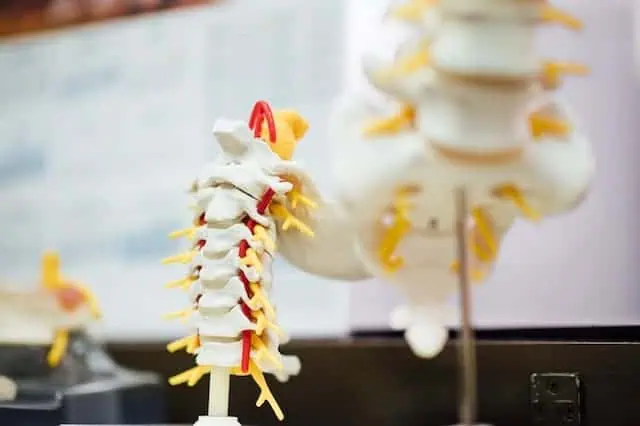What Is Chiari Malformation?
People who have brain tissue that extends into the spinal canal due to a small or misshapen skull have a condition known as Arnold Chiari malformation (commonly known as Chiari malformation). The skull presses on the brain and forces the tonsils of the cerebellum into the upper spinal canal.

This can interfere with the flow of cerebrospinal fluid, which protects your spinal cord and brain, leading to a buildup of spinal fluid in those areas or causing neurological symptoms. While Chiari malformation is uncommon, it is being diagnosed more frequently due to the increased use of imaging tests.
There are two main types of Chiari malformation. Your type depends on whether there are developmental abnormalities of the spine and brain and the anatomy of the brain tissue displaced into the spinal canal.
- Type I develops as the brain and skull grow, so it may not be discovered until adulthood or late childhood.
- Type II is a pediatric form present at birth.
There are two main types of Chiari malformation. Your type depends on whether there are developmental abnormalities of the spine and brain and the anatomy of the brain tissue displaced into the spinal canal.
- Type I develops as the brain and skull grow, so it may not be discovered until adulthood or late childhood.
- Type II is a pediatric form present at birth.
Chiari malformation can lead to several serious complications, including:
- Tethered cord syndrome – when the spinal cord attaches to your spine and stretches, leading to muscle and nerve damage in your lower body.
- Syringomyelia – a cyst or cavity that appears within the spinal column.
- Spina bifida – When your spinal cord or cord covering isn’t fully developed, it exposes a portion and makes you susceptible to paralysis. A common form of spina bifida in people with Chiari malformation type II is myelomeningocele, and
- Hydrocephalus – when you accumulate excess fluid in your brain. You may need a flexible tube, or shunt, placed in the problem area to drain and divert the cerebrospinal fluid to another part of your body.
Is Chiari Malformation a Disability?
Patients who find themselves unable to work because of their Arnold Chiari malformation and its related complications may qualify for long-term disability (LTD) benefits from disability insurance companies. It is also possible for patients to qualify for Social Security Disability benefits from the Social Security Administration.
Disability Evaluation of Chiari Malformation
The CDC defines Chiari malformation as a brain and spinal cord disorder with neurological or physical issues that interfere with personal, social, school, or work activities; have no other physical or mental cause; and appear in imaging tests. Symptoms include:
Chiari Malformation Type I
- Hoarseness or other speech problems;
- Blurry or double vision, as well as other vision issues;
- Trouble swallowing that is sometimes accompanied by choking, gagging, or vomiting;
- Being lightheaded or dizzy;
- Tingling or numbness in the feet or hands;
- A lack of fine motor skills, such as poor hand coordination;
- Balance problems such as an unsteady gait;
- Neck pain.
Chiari Malformation Type II
- Arm weakness;
- Quick downward eye movements;
- Problems swallowing, including gagging;
- Breathing pattern changes.
Less frequently, those with Chiari malformation may suffer from the following:
- Central sleep apnea or other abnormal breathing;
- Scoliosis (curvature of the spine) related to spinal cord impairment;
- Decreased heart rhythm;
- Body weakness, and
- Tinnitus (buzzing or ringing in the ears).
To qualify for a diagnosis of Chiari malformation, your medical records should document the above criteria.
Long-Term Disability Claims
Every long-term disability policy is different, so be sure to review your specific policy to see how the terms “disability” and “totally disabled” are defined. However, most LTD policies consider you disabled if you are:
- Unable to perform the job duties of your own occupation (for the first two years that benefits are payable.)
- Unable to perform any viable occupation’s duties (after the first two years that benefits are payable have elapsed.)
Insurance companies will assign an adjuster to your claim who may have a psychologist, physician, or other medical disability examiner review your file and determine your level of impairment. Your adjuster should consider all evidence, including treatment from the onset of the illness and the impact of the illness on affected body systems.
It is your responsibility to submit medical evidence in support of your claim. Your doctors must include all objective findings related to your condition, even those about another disorder. You may also be required to complete a functional capacity evaluation or an independent medical examination, which are medical tests often required by insurance companies.
Social Security Disability Claims
Many patients with Chiari malformation may qualify for Social Security Disability benefits as well, although disability claims with the Social Security Administration have different requirements. You or your attorney must prove that you cannot perform your job, or any other work you may be qualified for, for at least 12 months.
Get Help with Your Disability Claim
If you suffer from the effects of Chiari malformation and it prevents you from performing your job duties adequately, you should consider filing for disability benefits. If you’ve been denied LTD despite a genuine disability, Ortiz Law Firm can help. Call us at (888) 321-8131 to find out how we can get you the benefits you deserve.

